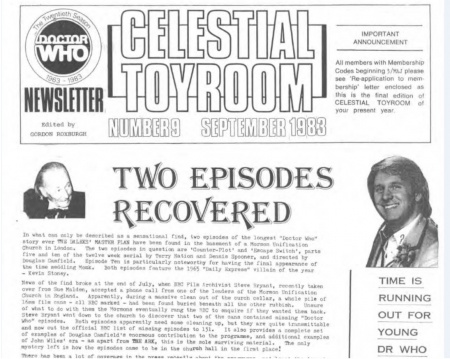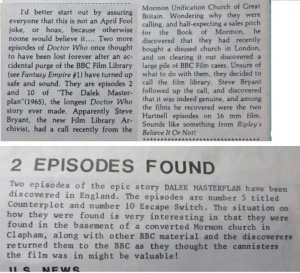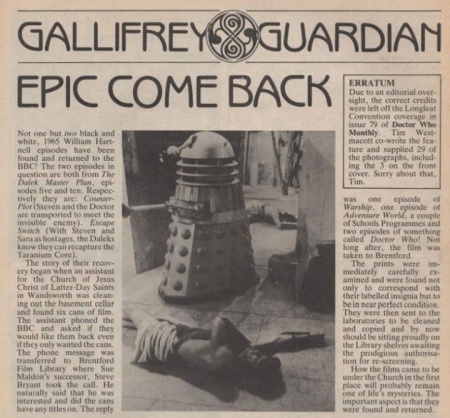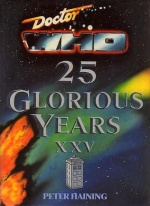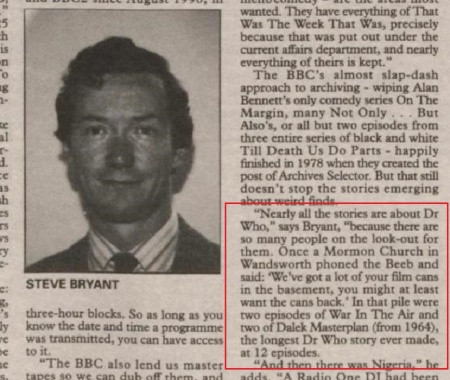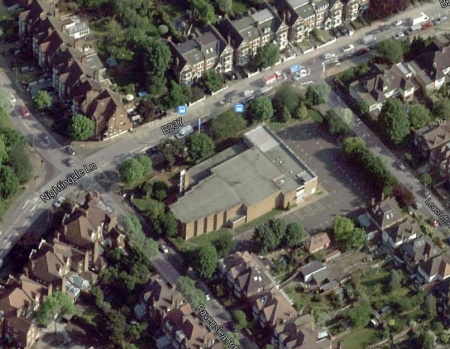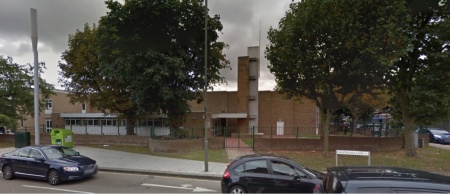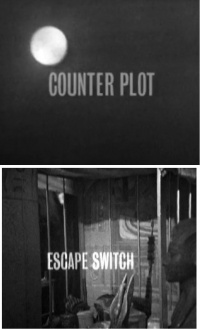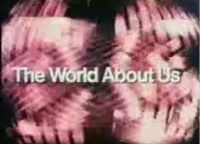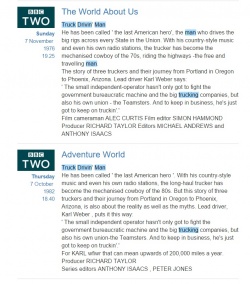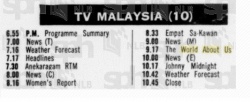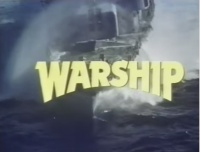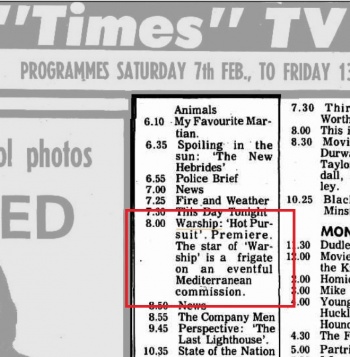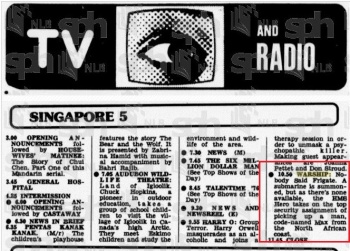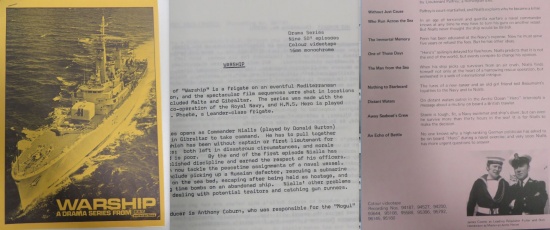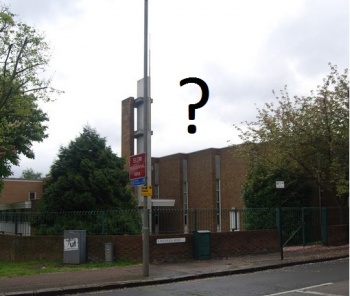Difference between revisions of "Mormon Mystery"
Jon Preddle (talk | contribs) |
Jon Preddle (talk | contribs) |
||
| Line 310: | Line 310: | ||
===Warship (1 episode)=== | ===Warship (1 episode)=== | ||
[[File:Warshipcaption.jpg|200px|frameless|left]] | [[File:Warshipcaption.jpg|200px|frameless|left]] | ||
| − | [[File:WarshipABC1976.jpg|thumb|right|350px|Warship debut listing for | + | [[File:WarshipABC1976.jpg|thumb|right|350px|Warship debut listing for Adelaide, Australia; 11 February 1976]] |
[[File:WarshipRTS1976.jpg|thumb|right|350px|Warship episode 2 in Singapore; 12 August 1976]] | [[File:WarshipRTS1976.jpg|thumb|right|350px|Warship episode 2 in Singapore; 12 August 1976]] | ||
[[File:ABCWarship.JPG|right|thumb|550px|BBC sales brochures for "Warship" series 1 (b/w and colour) and 2 (colour only)]] | [[File:ABCWarship.JPG|right|thumb|550px|BBC sales brochures for "Warship" series 1 (b/w and colour) and 2 (colour only)]] | ||
Revision as of 21:15, 6 June 2018
The Mormon Master Plan Mystery
In July 1983 two missing episodes of The Daleks' Master Plan were supposedly found in the basement of what may or may not have been a converted Mormon church that may or may not have been in Wandsworth, and which could have been but probably wasn't a building that had previously been owned by the BBC.
Or something to that effect.
Now, we said "supposedly" because, truth be known, there does not appear to be one single account that is wholly reliable. The story of the return didn't reach the fan-press until September (no email or interweb back then, kids!), and it wasn't until mid-October that DWM reported the find. Since the magazine's editorial lead-in and publishing schedule was less-flexible than the fan publications, DWM was more than likely fully aware of the recovery quite soon after it had occurred, and also had better access to the people concerned with reporting the recovery.
So let's break down what we do "know", remove what's clearly false, and try and get a sense of what really did happen in 1983.
What was said in the Fan-Press
Numerous fan publications reported on the return of the episodes around September, and each told the story slightly differently. The news told excitedly over a bad phone line or across the table in a noisy pub can probably be to blame for these many inaccuracies.
These fan-zines are often dated with the month of publication; the following is our best-guess as to the "order" in which they were published and circulated:
- TWO EPISODES RECOVERED
- In what can only be described as a sensational find, two episodes of the longest "Doctor Who" story ever THE DALEKS' MASTER PLAN have been found in the basement of a Mormon Unification Church in London. The two episodes in question are 'Counter-Plot' and 'Escape Switch', parts five and ten of the twelve week serial by Terry Nation and Dennis Spooner, and directed by Douglas Camfield.
- News of the find broke at the end of July, when BBC Film Archivist Steve Bryant, recently taken over from Sue Malden, accepted a phone call from one of the leaders of the Mormon Unification Church in England. Apparently, during a massive clean out of the church cellar, a whole pile of 16mm film cans – all BBC marked – had been found buried beneath all the other rubbish. Unsure of what to do with them the Mormons eventually rang the BBC to enquire if they wanted then back. Steve Bryant went down to the church to discover that two of the cans contained missing "Doctor Who" episodes.
- The only mystery left is how the episodes came to be in the church in the first place!
- Celestial Toyroom [UK]; issue # 9 (September 1983) [pg 1] {author, Gordon Roxburgh}
- [Comment: This is the first of several inaccurate reports to name the organisation as the Mormon Unification Church rather than the Church of Jesus Christ of the Latter-Day Saints. Was the MUC just a lazy shorthand for COJCOTLDS?]
- DALEK EPISODES FOUND
- Quite the most important Dr Who find of the '80s was recently accomplished of all places … in the basement of a Mormon Unification Church in London!
- Two episodes of the mammoth story 'Dalek Masterplan' were found following a clean out of the Church cellar towards the end of July.
- The episodes in question are 5 & 10: 'Counter-Plot' and 'Escape Switch'. They are both transmittable and cut down the number of missing episodes to 131.
- Steve Bryant has replaced Sue Malden as the head of archives and is keen to find more missing Dr Whos.
- DWB [UK]; issue # 2 (September 1983) [pg 3] {author, Gary Levy}
- [Comment: Since this report does not contain anything contradictory to any of the others, we are certain this story was taken from the CT.]
- BUNDLES FROM BRITAIN
- Two more episodes of Doctor Who once thought to have been lost forever after an accidental purge of the BBC Film Library … have turned up safe and sound. They are episode 2 [sic] and 10 of "The Dalek Masterplan" (1965), the longest Doctor Who story ever made. Apparently Steve Bryant, the new Film Library Archivist, had a call recently from the Mormon Unification Church of Great Britain. Wondering why they were calling, and half-expecting a sales pitch for the Book of Mormon, he discovered they had recently bought a disused church in London, and on clearing it out discovered a large pile of BBC Film cases. Unsure of what to do with them, they decided to call the film library. Steve Bryant followed up the call, and discovered that it was indeed genuine, and among the films he recovered were two Hartnell episodes on 16 mm film.
- Fantasy Empire [United States]; issue #7 (October 1983) [pg 8] {author, John Peel}
- [Comment: This is the first report that mentions the "sales pitch" angle (see also Haining below) and also the first to introduce the idea of it being a "disused" church. Peel doesn't mention that it was a basement or cellar.]
- 2 EPISODES FOUND
- Two episodes of the epic story DALEK MASTERPLAN have been discovered in England. The episodes are number 5 titled Counterplot and number 10 Escape Switch. The situation on how they were found is very interesting in that they were found in the basement of a converted Mormon Church in Clapham, along with other BBC material and the discoverers returned them to the BBC as they thought the cannisters the film was in might be valuable!
- Data Extract [Australia]; issue # 23 (September 1983) [pg 2] {author, Dallas Jones}
- [Comment: This is the only fanzine report that mentions the location being a "converted church", so chances are it post-dates the above CT and DWB reports. But quite where the idea of the church being "converted" comes from is unknown. It's also the first and only to place the location in Clapham, whereas the other fan reports just say "London". Clapham is a mere stone's throw from Wandsworth.]
- EPIC COME BACK
- Not one but two black and white, 1965, William Hartnell episodes have been found and returned to the BBC! The two episodes in question are both from The Dalek Master Plan, episodes five and ten. Respectively they are: Counter-Plot (Steve and the Doctor are transported to meet the invisible enemy), Escape Switch (With Steven and Sara as hostages, the Daleks know they can recapture the Taranium Core).
- The story of their recovery began when an assistant for the Church of Jesus Christ of Latter-Day Saints in Wandsworth was cleaning out the basement cellar and found six cans of film. The assistant phoned the BBC and asked if they would like them back even if they only wanted the cans. The phone message was transferred to Brentford Film Library where Sue Maldon's successor, Steve Bryant took the call. He naturally said that he was interested and did the cans have any titles on. The reply was one episode of Warship, one episode of Adventure World, a couple of Schools Programmes and two episodes of something called Doctor Who! Not long after, the film was taken to Brentford.
- How the films came to be under the Church in the first place will probably remain one of life's mysteries. The important aspect is that they were found and returned.
- Doctor Who Monthly [UK]; issue #82 (November 1983; actual publication was October) [pg 5] {author, Richard Landen}
- [Comment: DWM was probably aware of the find early on, and its story written without being polluted by what fans and the fan-press were saying elsewhere, but its fixed publishing schedule meant it wasn't first with the news.]
Common Factors
If we take all the key points that are common to each of these reports, all of which were published in September or October 1983 (so there was only a very brief period of time for "Chinese Whispers" to distort the "facts"), it's clear that even with only a very brief time separating each report, misinformation has already begun to creep in:
| Reported in | Type of Church | Location | Who | Where | In What | How Many |
|---|---|---|---|---|---|---|
| DWM 82 | Church of Jesus Christ of Latter-Day Saints | in Wandsworth | an assistant for | basement cellar | six cans of film | |
| CT 9 | Mormon Unification Church | in London | one of the Leaders | basement / church cellar | buried beneath rubbish | whole pile of 16mm film cans |
| DWB 2 | Mormon Unification Church | in London | basement / church cellar | |||
| FE 7 | disused church purchased by Mormon Unification Church of Great Britain | in London | a large pile of BBC film cases | |||
| DE 2 | Converted Mormon Church | in Clapham | basement | other BBC material |
None of these reports refers to the building being an ex-BBC property, so that aspect of the narrative was introduced much later
It's fairly clear from these reports that each author, or the person who had told them, had embellished the story somewhat, adding "facts" to the narrative in each re-telling.
Even when the finer details themselves have been distorted, these accounts at least can all agree on one thing, and that it was a number of films found in the basement of a Mormon Church in London. Supposedly.
Most telling too is that it is only in the two foreign based publications – Australia's Data Extract and the US Fantasy Empire – that the notion of the church being "disused" or "converted" appears. The respective writers would no doubt have got the news over the phone and depending on how the story was related to and noted down by them offers why both these two reports contain such contrastingly and contradictory unique "facts".
Who to believe
Although DWM was certainly not the first publication to report on the find, we would certainly take its account in preference to any of the fanzines, simply because being the official publication, and they were able to speak with Bryant directly at the time to glean first-hand knowledge, which gives them the clear edge over the second/third/fourth-hand gossip appearing in the fan-produced material.
Later Reports
The story of the recovery of those two episodes continued to get press for many years to come. Here are just some of the ones that in their own way have continued to add to the confusion:
- Surely the most unexpected find of all, though, had to be parts five and ten of 'The Daleks' Master Plan', which turned up in summer 1983. Sitting at his desk at the BBC one morning, Steve Bryant took a phone call from his secretary asking if he would like to speak to representatives of the Mormon Unification Church of Great Britain. Wary of being sold a subscription for a series of religious publications, Bryant took the call. To his amazement he found himself speaking to one of the Church leaders who was phoning from their newest temple in Clapham, south London. Apparently, having just acquired this previously long-derelict church, the Mormon disciples were busy cleaning out the basement when they came across an old crate in one corner marked 'BBC Property'. Opening it, they discovered inside a dozen or so cans of 16mm film, again emblazoned with the BBC logo. Did the BBC want them back? His curiosity aroused, Bryant went to visit the Mormon temple, and was staggered to find the two missing episodes of Doctor Who in the crate, nestling alongside an early edition of the drama series Warship, among others. All the episodes were safely restored to the Library, but to this day no one is any the nearer solving the mystery of just how the crate came to be in that church basement.
- Doctor Who: 25 Glorious Years; W H Allen (1988) [pg 208] {author, Peter Haining}
- [Comment: Of note, Haining's account contains many 'unique' elements, but also in part mirrors that of John Peel's as reported in Fantasy Empire, specifically the line about selling a subscription! But much of Haining's account has to be false. He somehow has the impression that the "new" temple was an old "abandoned" church, and he's the first to introduce the notion that the films were in a crate rather than loose, and that there was twice as many films as reported elsewhere!]
- The next episodes to turn up did so in the most unusual of circumstances, when The Dalek Master Plan 5 and 10 (Counterplot and Escape Switch) were recovered from the cellar of a Mormon church in London by Steve Bryant shortly after his appointment as Sue Malden's successor in July 1983. We don't know how they got there but he was very excited about making such a find so quickly.
- DWB [UK]: issue #104 (August 1992) [pg 12] {author, Ian Levine, Gary Leigh}
- The Daleks' Master Plan 5 & 10: found in (of all places) a church basement in London in October 1983.
- DWB Compendium / The Best of the First 100 Issues (UK) (post-October 1993) {author, Richard Molesworth}
- [Comment: Richard states here that the recovery was in October.]
- A church in London (the name of which varies depending on whom you talk to) was having its basement cleared when half-a-dozen film cans with BBC stickers on them were discovered. The films were offered back to the BBC, where two of them turned out to be the fifth and tenth episodes of The Daleks' Master Plan, Counter Plot and Escape Switch.
- Doctor Who Magazine [UK]; issue # 257 (September 1997) [pg 49] {author, Richard Molesworth}
- In October 1983, 16mm films of Counter Plot and Escape Switch were located in the basement of a Wandsworth church.
- Doctor Who Magazine [UK]; issue # 272 (November 1998) [pg 30] {author, Andrew Pixley}
- [Comment: Andrew repeats the "found in October".]
- For many years, the entire story was thought lost until two episodes were recovered in 1984 by the Mormon Unification Church of Great Britain during a clean up of a London church.
- A Critical History of Doctor Who on Television [United States]; McFarland & Company Inc (1999) {author, John Kenneth Muir}
- [Comment: Muir gets the year wrong, but otherwise has duplicated what was said by John Peel in Fantasy Empire. (Peel gets a 'thanks to' in the acknowledgements.)]
- Episodes 5 ("Counter Plot") and 10 ("Escape Switch") were returned in 1983 after being discovered in a trunk inside a LDS Church in Clapham, South London.
- [Comment: It's unclear where the notion of the films being found inside a trunk came from – perhaps a re-interpretation of Haining's 'crate'?-- but since "trunk" is an Americanism, that at least informs the nationality of the author.]
- Episodes 5 and 10 came from an ex-BBC property which had been purchased by an LDS Church group in the early 1980s, who had come across the films when tidying the basement and subsequently offered them back to the Corporation.
- [Comment: This is the only reference to it being an "ex-BBC property" that had been purchased by the church, which has been informed from the fan-myth, the exact origins of which are unknown.]
Many other books and magazines have briefly covered the recovery of the two episodes; all pretty much repeat and echo the same "facts" outlined above.
Steve Bryant
One of the key players in the saga was Steve Bryant. He was the Head of the BBC Film and Videotape Library at the time, having then recently taken over from Sue Malden.
In an interview published in the 4 July 1991 edition of Stage & Television Today, only eight years after the films were found, his own memory of the incident had become somewhat vague:
- "Once a Mormon Church in Wandsworth phoned the Beeb and said: 'We've got a lot of your film cans in the basement, you might at least want the cans back.' In that pile were two episodes of War in the Air and two of Dalek Masterplan (from 1964), the longest Dr Who story ever made, at 12 episodes."
Here he recalls there being two prints of "War in the Air", which is a BBC series from the mid-1950s. Could it have actually been an error on DWM's part, and it was in fact this 1950s series rather than the 1970s series "Warship"?
In all likelihood, Bryant is getting his facts slightly askew here, miss-remembering the title of the "War" series and number of prints that had been found in the cellar.
In 2005, researcher Richard Bignell contacted Bryant for Nothing at the End of the Lane issue # 2, seeking to clarify some points. He asked Bryant:
- Is there any truth to the way these episodes were recovered?
- Did you have to go and collect the films yourself?
- Were they really found in the basement of a Mormon building? If so, where was it in London?
To which Steve replied:
- "It is largely true, but I did not go there myself. They rang the then Assistant Head of the BBC Film and Videotape Library, Gareth Morris, who suggested that they send the films in to me, which they did. They were definitely in a Mormon church, but I cannot confirm whether they were in a basement or not and I do not know where the church was."
And in his second edition of Wiped! Doctor Who's Missing Episodes (Telos, 2013), Richard Molesworth highlights some of the contradictions published about the recovery (specifically identifying Haining's 1988 account as being the most problematic in terms of accuracy!) and also sought out Bryant for clarification, who says:
- "It was not actually I who took the call from the Church – it was the then Deputy Head of the BBC Film and Videotape Library, Gareth Morris. He arranged delivery of the cans to Windmill Road [location of the library] and then passed the job of identifying what may be worth keeping to me. He didn't really take much notice of the details – as far as he was concerned it was just a case of getting what was most likely to be a pile of junk delivered to the right address so that we could check it out. It was only his vague recollection, passed on to me in a jokey sort of way, that it was a Mormon Church, which is the basis of the story. It could be wrong. I was more interested in the ramifications of the recovery than in the details of where the cans had been and why."
Richard also raises the possibility that the "Mormon church" story may have been a smoke screen to hide the real story behind the recovery. Were the films actually handed over by a film collector who wanted to maintain his anonymity, and who phoned the BBC claiming to be from a Mormon Church as a cover, or even a joke?
It is a great pity that Bryant didn't take much interest in "the details of where the cans had been and why", as a close examination of the film cans, reels, and prints themselves, and further enquiries to the Church as to the circumstances surrounding how these films were found, could have provided vital clues as to not only where the films had come from but also as to the likelihood of there being more of them!
And we have been in touch with Gareth Morris (he moved to Cardiff in the late 1980s to work at BBC Wales, and has long-since retired), but as the Mormon Mystery was 32 years ago, he was unable to shed any new light on the matter.
The Chapel on Nightingale Lane
Of course, while there is the very strong possibility that the "Mormon Church" story was a fabrication (the person who phoned the BBC in July could have been telling porkies or simply having a laugh), they did hand over the films, so if they were telling "lies" does it really matter?
But if we accept that the church story is in fact true, where is this place?
Steve Bryant is fairly certain that it was a Mormon Church, be it in Wandsworth or somewhere else. And such a Mormon Church does indeed exist; the Wandsworth Chapel is at 149 Nightingale Lane, between Ravenslea Road and Leacroft Avenue.
But the fan reports that the building was once owned by the BBC and had been converted into a Church are clearly false, considering that site has been occupied by a Mormon place of worship of some description since 1935. Here is a brief history of the church at that location:
- 149 Nightingale was the site of "Ravenslea", a large Victorian detached house. It was built just before the turn of the century and was then the residence of a London architect. (Reference 1) and (Reference 2)
- In 1935, "Ravenslea" was purchased by Hugh Brown for the Mormon church. In 1939 it became the headquarters for the British Mission. Ravenslea was a large house, and combined the mission offices, the family residence, and a chapel under the same roof. The ballroom was often used for dances and other social events. At that time it was the only mission for the whole of the British Isles. (Reference)
- The privately-owned building stood on half an acre of land, and during the war served as a refuge during German bombing raids. (Reference)
- In 1948 it underwent remodelling, but the Victorian building was completely demolished in the late 1960s, to make way for a modern church, the new Wandsworth chapel, which was completed in 1977. (Reference 1 and Reference 2)
- The Wandsworth stake was one of 21 new stakes organized in the 1970s. (Reference)
- The new Chapel had its "unit creation date" on 28 May 1978. (Reference)
- And during 1979 and 1980, alterations were made to the church by noted architect Leslie Gooday. (Reference)
- In July 1983 several cans of film belonging to the BBC were found (supposedly) in the six year old church's basement…
|
|
These online sources all clearly show that the Mormon Church on Nightingale Lane, Wandsworth has been there in one form or another since the 1930s, so it definitely was not an ex-BBC property that had been converted into a church in 1983! And it's also highly unlikely that the "basement" containing the films was a remnant of the demolished "Ravenslea" house.
However, there is a remote possibility that although it was a member of the Wandsworth chapel that had phoned the BBC in 1983, it wasn't necessarily at the church itself that the discovery was made, but at another property somewhere else that the church members were clearing out, and it was that other location which had once been a BBC storage facility. However since the notion that the building in question was an ex-BBC facility taken over by the church is something that has probably been added to the story by fan gossip that has gained traction much later on (even appearing as a question in the recent Doctor Who Quiz Book!), should we dismiss that particular aspect and remove it from the narrative?
What was in the cans?
The table above shows that the reports on the actual number of cans found were all wildly different, ranging from just the six that were named in DWM 82 to at least a dozen!
It's not clear from Bryant's account in Wiped! whether the identification of two of the films being Doctor Who happened at the time of the phone call or only after the films had been delivered to him at Windmill Road. If the person who rang the BBC told them over the phone that the films were Doctor Who, then that would only have been possible if both cans had not only the series title labels on them but also standard BBC labels, otherwise how else would they have known to ring the corporation?
The very fact that in the sound bites from Bryant he does not mention there being any non-BBC labels, does strongly suggest there weren't any; an overseas broadcaster had not affixed any other stickers or labels to the can or reels. Of note, all the Doctor Who films that have been returned from Hong Kong bear labels for the station "RTV". It is also known that the ABC in Australia and New Zealand's NZBC often affixed their own labels to film cans. That there may not have been other identifying marks or labels on the recovered cans, we think is highly significant.
As noted by DWM in late 1983, there were six cans, four of which were identified by series name. (We can ignore the two Schools Programmes since there were thousands of those made over the years!). The other films that were found were:
Doctor Who: The Daleks' Master Plan (2 episodes)
Other than the BBC stickers displaying at least the titles "Dr Who Series V Episode Five Counter Plot" and "Dr Who Series V Episode Ten Escape Switch", there were apparently no other identification markings on any of the cans or reels. Which is a great pity. But the fact that there were no other markings in itself might actually be a clue.
The serial was offered to the Australian Broadcasting Commission (ABC) in March 1966. As we've already summarised HERE, the serial was withdrawn from offer in March 1967 following disputes between the BBC and the Australian film censorship board. Since the ABC never purchased the films, they remained the property of the BBC. And there's the biggest clue. The films that the BBC supplied to the ABC would have had BBC labels on them. After purchasing a series, the ABC always affixed its own labelling to film cans, and it is on these stickers that the ABC notated its cataloguing codes, etc. But since the Master Plan films were never purchased or catalogued, the labels were never changed by the ABC.
Again, as outlined HERE, it's doubtful that the BBC would have had a second set of prints "on the shelf", therefore it's unlikely that the three prints of Master Plan that have since turned up are from another set.
On the assumption (!) that the BBC's Sydney office returned the unsold films to London bearing only the original BBC stickers, that would account for why there were no other tell-tale stickers on the cans found in the church. To put it another way, if these films had distinctive ABC stickers on them, surely Steve Bryant would have mentioned that back in 1983?
Adventure World (1 episode)
"Adventure World" was the umbrella title given to a short repeat run of episodes of the long-running BBC natural history documentary series "The World About Us" which ran from 1967 to 1987 (as noted in the BBC's Genome database).
While "The World About Us" played in its regular weekly slot on Sundays at the same time, "Adventure World" played on Thursdays, in two blocks, from 16 September to 14 October 1982 and 27 January to 17 February 1983. (The reason why the BBC should rename the series is unknown, but it's possible this was done to avoid confusion by having two different episodes of "The World About Us" playing the same week but on different days.)
What's interesting here is that if a film labelled "Adventure World" was found in July 1983, then it could have only been there for a few months at most!
However, there is a slight possibility that what was found in the church was actually one of "The World About Us" editions, and Steve Bryant miss-identified it as being from the alternative series. If the film can and/or reel only bore the edition title and not either umbrella title (which is reasonable, since many editions of the series were not made in the UK and were bought-in by the BBC from independent documentary-makers, and screened as part of the on-going "The World About Us" series in name only) did Bryant only find out the umbrella title after accessing the BBC's database and inputting only the edition title, and have the computer to spit out "Adventure World", even though the film print he was holding was not the one that was broadcast only a few months earlier? If so, then the film could have been in the church for longer than a year. Sadly, since the title of the episode in question was never revealed, we cannot even begin to determine what year (or indeed which umbrella title) the film hailed from.
Also not revealed was the format -- was it colour or black and white? "The World About Us" aired on BBC2, and a such all editions would have been in colour. If it was in black and white, it's possible it was intended for an overseas broadcaster yet to convert to colour.
"The World About Us" was a regular feature in the BBC's sales catalogues, and as such was probably sold to many countries around the world – it definitely sold to Malaysia, Australia and New Zealand. (Exact airdates for New Zealand are not known, but the series did play in colour from late 1973, 1974 and 1975.) The Australian screenings commenced soon after the UK debut. (The earliest OCR listing we could find online was for "Beyond the Last Oasis", the episode that was aired by the Sydney and Canberra ABC channel on 25 December 1968; this episode had screened in the UK on 4 February of that same year.)
Malaysia aired the series in black and white during the 1970s.
The series was still playing in Australia when colour transmissions commenced in early 1975, and listings for the series in Australia can be found right up until 1986.
So if the film had been returned from overseas, there are already several candidates for that action. Of course, since Australia was the only country to acquire The Daleks' Master Plan, there is a strong possibility that Australia was the origin for both sets of films…
Warship (1 episode)
The other named episode found in the church was from "Warship", as was reported in DWM 82 -- or was it "War in the Air", as stated by Bryant in 1991?
There were four seasons of the naval series featuring the frigate HMS Hero made by the BBC: the first of nine episodes ran from 7 June to 9 August 1973. The second (with 10 episodes) from 15 October to 17 December 1974. The third (13) was 6 January to 30 March 1976, and the last of 13 from 4 January to 29 March 1977.
Like most BBC colour series of the day, location footage was shot on 16mm film, and studio interiors recorded on PAL videotape, with broadcast also from video.
The very fact that it was a 16mm film of "Warship" that had been found means it must have been a telerecording, and presumably in black and white. Unfortunately, since the title of the episode has never been disclosed we don't know from which of the four series this came, but there is a good chance that it was a print from the first series.
Like Doctor Who, "Warship" was sold widely by the BBC. And of course it was purchased by the ABC in Australia. But the ABC did not screen the series until January 1976, which was a full year after the launch of colour in the country, and when it did, it played seasons one, two and three back to back, with the last few series three episodes playing only a matter of months after screening on the BBC.
It's highly unusual for the ABC to pick up a BBC series already three seasons in, so it could be that the ABC had already auditioned the first season a few months after the series had ended in the UK -- which would be circa early 1974 -- and on black and white film, since the ABC had yet to convert to colour at that stage (the ABC was still screening the Pertwee Doctor Who episodes in black and white), but by the time the decision to purchase was made, they had held off screening the series until after colour transmissions had commenced. (The NZBC debuted the series from 12 January 1976, and Singapore's channel 5 from 5 August 1976; as was usually the case with BBC material, the NZBC and RTS had to wait until after the ABC had purchased the series before they could.) And by the time the first series was supplied in colour to Australia, the second series was also on offer. It therefore makes sense that the ABC would purchase the first two series plus the forthcoming third at the same time, and then air them all in one long run.
The fact that three countries in the same region, Australia, New Zealand and Singapore, all debuted "Warship" within a few months of each other in 1976, means that the sale to Australia affected when the other two could screen the series. And only Australia would have used an audition print in black and white. On that basis, we feel sure that the copy of "Warship" found in 1983 was indeed the ABC's audition print, and that it would have been returned to the BBC by the late 1970s…
- ADDENDA: The ABC's audition reports for "Warship" have been located on file at the National Archives of Australia in Sydney, and they confirm that the first episode of the series, "Hot Pursuit", was viewed on 10 January 1974 (some seven months after the UK airdate), and that it was indeed a 16mm telerecording print! (The BBC's sales brochure for the first series that was sent to the ABC states that the nine episodes were available on "Colour videotape" and "16mm monochrome".)
- The typed audition report gave it a "FAIR TO GOOD" grade for its entertainment value, commenting that "If we wish to take it for colour, perhaps a later ep could be requested for audition? At this particular stage, the decision to take the series would hinge greatly on how much drama we have, and whether the colour footage is of intrinsic importance…"
- Some 16 months later, on 27 May 1975, episode 3 from series two, "Who Runs Across the Sea", was viewed on half-inch colour video tape (it is even marked "AUDITION EPISODE" on the typed report). The assessment gives it a "GOOD" recommendation, and notes that the "colour value is good". The BBC's sales brochure for series two states that the ten episodes are available on "Colour videotape". Unlike the series one catalogue, there is no mention of the episodes also being available on 16mm monochrome film.
- Two months later, on 3 July 1975, another episode was viewed on tape: episode 5 from series two, "One of Those Days". The report states that "… the locales [play up] the colour factor…. The second series seems to be a distinct improvement on the first… having seen only one ep from that series…"
- Two more episodes from the first series were viewed later in the year, on 30 September 1975, "The Prize" (ep 6) and "Shoresides and Home" (ep 9) although the format wasn't stated. Both were "RECOMMENDED". The remaining series one episodes (including "Hot Pursuit" again), were all viewed on ¾ inch U-matic tapes on 30 December 1975 and 8 January 1976. The two seasons in colour were purchased and episode one aired a month later, in January 1976.
- What all this tells us is that our instincts (as given above) were correct: the ABC did receive one episode of "Warship" on 16mm black and white film, and they did wait until they had received further episodes in colour before making a firm decision to purchase the series.
- We feel sure that the unwanted 16mm print would have been returned to the BBC in London, and it is therefore indeed a VERY good chance that that same 16mm print was the one that ended up in the basement of that Mormon Church…
What does any of this mean?
What was found in 1983 were potentially two episodes of a Doctor Who serial that was offered to the ABC in 1966, one from an on-going series that aired there in the 1960s, 70s and 80s, and one that was offered in 1974 on film, but which didn't go to air until colour transmissions began two years later.
Sure, this is all circumstantial, and perhaps coincidence! We're certainly not saying "because the ABC acquired Master Plan and The World About Us and Warship that all these films came from Australia". The ABC bought a lot of BBC material over the years, so it's perfectly reasonable to expect that they would have eventually acquired "The World About Us" and "Warship".
If they did all come from down under, there's nothing to suggest that they were sent at the same time. The fact that they were found together doesn't mean they were put in the church together. But we do know that the ABC returned a large consignment of Doctor Who films to the BBC in 1975. It's therefore reasonable to assume that that shipment also included other BBC films.
The BBC was meticulously disposing of many old film prints during the 1970s, so it's pretty much a given that the two Master Plan episodes, the "Warship" print and the "Adventure World" film, plus the two Schools programmes, would in time be destined for the incinerator. And in the same manner that many other Doctor Who episodes were rescued, these six prints were saved from that fate. Whether all were saved by the same person, at the same time, is unknown, but they ultimately did end up together in the basement however many years it was later.
Final Conclusions
Where Did the Films Come From?
The two Doctor Who and the single "Warship" films, are we think the audition prints sent to but never catalogued by the ABC, which is why there were not also identifiable ABC labels on the cans. In other words, and in a very warped sense of logic, it's the lack of markings that would otherwise prove they had been in Australia that indicates they had been in Australia!
As for the edition of "The World About Us" / "Adventure World", that could have come from any one of several overseas broadcasters, but the lack of comment from Bryant about there being foreign markings would in this case suggest that the film may have been the BBC's own broadcast print from the 1982/83 repeat, or a duplicate. (And if it was from the 1982/83 series, it was very remiss of the BBC to lose it so soon after broadcast!)
Where Were They Found?
If the Mormon Church story is true and not a complete fabrication by the person at the other end of the phone who spoke with Gareth Morris, one thing that we can be certain about is that the Wandsworth Chapel itself was not and has never been an ex-BBC property. The chapel building as it is today has been there since 1978, which means those films must have been put there at some point between 1978 and 1983, which is a very small window of time.
Although Steve Bryant recalls that it was members of the Mormon church in Wandsworth who had phoned, and since he never followed up or pressed for any further information, it's entirely plausible that he and Gareth Morris were never told the full story, and that while the films were indeed recovered by the members of that particular church they could actually have found by them somewhere else.
Could it have been a disused building somewhere (also in Wandsworth?) that was an ex-BBC property that they were clearing out to convert into a church meeting house? Or as noted earlier is that part of that narrative still only a fan-embellishment?
How Did They Get There?
How and why these films ended up in the basement cellar of the building will probably forever remain unanswered.
There's a GREAT BIG QUESTION MARK still hanging over much of this, as the possibilities are virtually endless.
If it was indeed the cellar of the Nightingale Lane property (which means they were put there between 1978 and 1983), or that of another place altogether (the "Warship" print can't have been there any earlier than 1973), was it the BBC itself that had put them there? And if so, why? The BBC had many facilities in Central London where it could store films, such as at its own Film Library in Brentford; why would it need to store material all the way across town in South London, so far from all its other facilities?
Had the films been hired out for screening by the church? But if so, shouldn't there be at least some form of "sales" record of such a transaction? (And with the Doctor Who episodes featuring the Daleks, wouldn't there need to be some agreement with Nation and his agents for this screening? Roger Hancock was notoriously protective of the Daleks in the late 70s and early 80s. Would he have allowed a "free" screening of a Dalek episode, even by a church?) And if they had been hired, why were they not returned, and why didn't the BBC follow up?
Had the films been hired by someone or another organisation (i.e what the BBC termed a Non-Theatrical sale), and it was they who were keeping them at the church for safe-keeping, and left them there? But again, why no permanent record of this, and why no follow-up when they weren't returned?
Perhaps one of the men who built the new church in 1978 left them there?! Or maybe they were left behind by Leslie Gorday in 1980?!
But the solution we favour is that the films had been salvaged by someone who rescued them from destruction by BBC Enterprises a few years earlier (perhaps under very similar circumstances by which episode two of The Daleks' Master Plan had been "rescued" in the early 1970s?).
This person (perhaps even a BBC employee?) stored them in the cellar of his newly-built local church (either with or without their permission; did they have a 16mm film projector he wanted to make use of?), but then died, moved away, forgot about them, or let them be found! (Who knows, he may even have been the person who rang the BBC!)
Or maybe this person or their family donated the films to the church for a local community fair, jumble sale or car boot sale (maybe a fair was held to celebrate the opening of the new chapel in 1978?), and the unsold goods were left at the church…
Have we succeeded in our mission to "try and get a sense of what really did happen in 1983"? Maybe. We've at least clarified the history of the LDS Chapel in Wandsworth: it was only six years old when the films were found. And it wasn't an ex-BBC building. And "Adventure World" is actually "The World About Us". As for finding clear and definite answers as to how the films got there, and where they came from…?
Well …. we will probably never know for sure…
With grateful thanks to Richard Bignell
